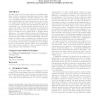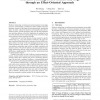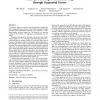22 search results - page 1 / 5 » Analyzing concurrency bugs using dual slicing |
ISSTA
2010
ACM
13 years 11 months ago
2010
ACM
Recently, there has been much interest in developing analyzes to detect concurrency bugs that arise because of data races, atomicity violations, execution omission, etc. However, ...
ASPLOS
2010
ACM
14 years 2 months ago
2010
ACM
Debugging concurrent programs is difficult. This is primarily because the inherent non-determinism that arises because of scheduler interleavings makes it hard to easily reproduc...
ASPLOS
2010
ACM
14 years 2 months ago
2010
ACM
Multicore technology is making concurrent programs increasingly pervasive. Unfortunately, it is difficult to deliver reliable concurrent programs, because of the huge and non-det...
ASPLOS
2011
ACM
12 years 11 months ago
2011
ACM
Concurrency bugs are caused by non-deterministic interleavings between shared memory accesses. Their effects propagate through data and control dependences until they cause softwa...
KBSE
2005
IEEE
14 years 1 months ago
2005
IEEE
Software debugging is the process of locating and correcting faulty code. Prior techniques to locate faulty code either use program analysis techniques such as backward dynamic pr...



